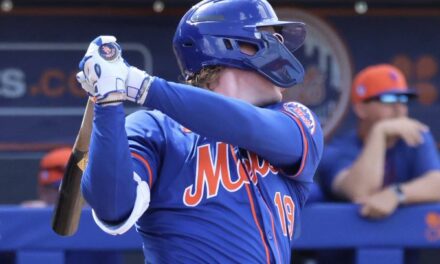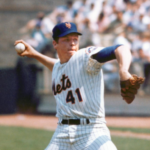
Chris Schwinden was drafted first by the Detroit Tigers in 2004 out of high school in the 43th round. He was a draft and follow for the Tigers as he went on to the College of the Sequoias. Schwinden went 5-4 with 1.78 ERA (32 runs/19 earned runs) in 14 appearances (13 starts) with the Sequoias during his freshman season and posted a 15:75 BB:K ratio in 96 innings with 79 hits allowed, but wound up not signing with the Tigers and continued his college career. For his senior season Schwinden transferred the Fresno Pacific University and excelled.
In his only season at Fresno Pacific Schwinden performed like the team’s ace and went 6-1 with a 2.48 ERA (28 runs/25 earned runs) in 13 starts. He threw three complete games and had a total of 90.2 innings in which he allowed just 63 hits and 22 walks, while setting a school record at the time with 96 strikeouts. The Mets took notice and he was drafted for a second time of his career in 2008 when he went in the 22nd round. Being a small school senior sign, he got an extremely small bonus that was barely enough to cover the cost of a wedding ring.
Schwinden was sent to Short-Season A Brooklyn Cyclones for the remainder of the 2008 season and started in the pen, but pitched his way into the rotation and wound up becoming one of the best pitchers on the staff. Among starters his 2.01 ERA was the second lowest just below Brad Holt and his 10.9 K/9 was again second best just behind Holt. He displayed outstanding command and led the team with a 1.7 BB/9 and a 5.83 K/BB.
He opened 2009 in Savannah and was in and out of the rotation until June when he earned a full-time role as a starter. He had a pretty solid season in the Sally, displaying outstanding command once again, but he did not wow anybody. He made 17 starts and posted a 3.28 ERA over 115.1 innings, although he got hit pretty hard. Batters posted a .297 batting average off him with 126 hits and his 88 strikeouts were very mediocre. He got a cup of coffee in St. Lucie at the end of the season and had one good start and one bad start.
Schwinden remained in St. Lucie briefly to open up 2010 before being promoted to Binghamton. While five of his seven appearances in St. Lucie were out of the bullpen he was pitching three to five innings in relief and wound up going 3-0 with a 1.83 ERA. His time in Binghamton was not as pleasant to him. Over 17 appearances (14 starts) he got hit harder than ever before to the tune of a 4-7 record with a 5.56 ERA. His control held up and his K/9 even increased, but he averaged under five innings per start and hitters were even better against him with a .306 batting average against. His BABIP was extremely high at .365 and his FIP was much lower than his ERA at 3.64, yet he remained nothing more than an organizational filler.
He was set to repeat Binghamton in 2011 and made two appearances out of the bullpen, but when Dillon Gee was promoted to fill in for Chris Young Schwinden got a chance to make a spot start for Buffalo. Schwinden was magnificent in that game and struck out nine in five innings, while allowing just a run. Ever since then Schwinden stayed up in Buffalo, remained in the rotation, and has thrived. In late May Schwinden had a 10-day layoff in between starts because the Mets needed him as insurance for R.A. Dickey, and the layoff appeared to affect him for a few starts, but he now looks to be back in form. He is having one of his best seasons at the moment with a 2.87 ERA in 15 starts spanning 87.2 innings and has pretty nice peripherals with a 30:75 BB:K. The walks are up and his BABIP is much lower than his career average, but his FIP is a solid 3.54.
There is every chance that this season is an apparition and his numbers will regress when his stats balance out, but I am not so sure that some of this success isn’t for real. Schwinden has been pitching away from contact more this year than I remember from his days in Buffalo and while his walk rates are up he is still commanding his pitches well.
He works mainly off a 88-91 mph fastball, topping out at 93 mph, that he is able to paint almost always on the black on either side of the plate. The fastball is a little straight for my liking, although he does get some nice arm side run when he elevates it in the zone to get some swings and misses. I have read a bunch of reports that state his changeup is his best secondary offering, but in my opinion the hammer curve is that pitch and his favorite to throw. It comes in mid-to-high 70’s and while at times the pitch can get a bit loopy when he leaves it high in the zone, when it is at its best he keeps it down in the zone and gets a late, hard 12-6 break. His changeup doesn’t get enough separation from his fastball and he leaves it up in the zone far too much to be a plus pitch, but it is still a serviceable third offering. While his slider doesn’t have a lot of break, it has tight movement at 85-87 mph and at times almost functions as a cutter. Although he doesn’t throw the pitch very often, he usually commands it well and keeps it down in the zone. He likes to throw it mostly to the left side of the plate and could benefit from starting it at right-handed hitter’s knees or trying to backdoor lefties.
While Schwinden isn’t the most overpowering pitcher on the planet, I do not like when people refer to him as not having enough “stuff” to get Major League hitters out. He is much like Gee, in that the overall command of his fastball and good off-speed pitch should be enough to keep hitters honest at the next level. In Gee’s case the pitch is a changeup, but for Schwinden it will be good old Uncle Charlie and being a guy who gets a lot of flyballs he could benefit greatly from pitching in Citi Field. He is still just a C prospect, but I don’t think it is out of the realm of possibility for him to have a Gee type of impact at some point this season or next.














